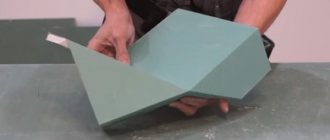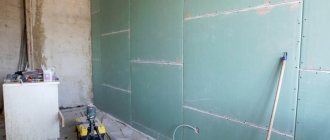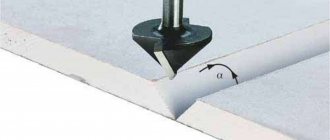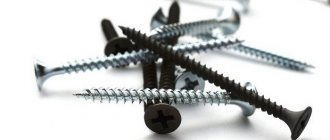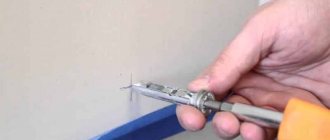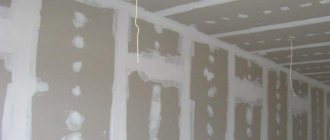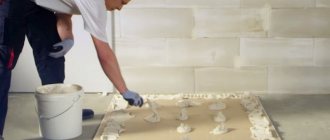24102 0 5
Icer October 22, 2016Specialization: master in the construction of plasterboard structures, finishing work and laying floor coverings. Installation of door and window units, finishing of facades, installation of electrical, plumbing and heating - I can give detailed advice on all types of work.
Drywall is one of the most popular finishing materials today, so the issue of attaching various elements to it is very relevant. There are a lot of fastening options, and today we will look at one of the most popular solutions – Butterfly drywall fasteners.
In the photo: Butterfly fastening for drywall is simple and reliable
What are butterfly dowels used for?
This device is intended for durable fastening of home interior elements to drywall. Drywall dowel Butterfly consists of two parts: expansion and static. The spacer part is inserted into a hole made in the plasterboard sheet and expands when the threaded fastener is screwed in, thereby making the connection strong. The dowel has a border that prevents it from falling into the drywall.
Many experts recommend using the Butterfly dowel to attach elements to drywall.
Attaching heavy objects to drywall
- If the distance of the cladding from the load-bearing wall is large, it is impossible to fasten massive elements.
- Anchors can only be used with appropriate wall materials (brick, concrete); fragile gas and foam blocks or raw brick will not withstand the load.
- A fixed heavy part cannot be moved to another area.
- The cross-section of the mortgage must be selected so that it practically touches the back side of the drywall sheet. The process of installing embeds in drywall
- Installation of bookmarks is possible only at the stage of assembling the frame; if there is a ready-made finish, it is unrealistic to use this technique.
Types of products
There are several types of fasteners of this type that are used in different situations, the following butterflies for drywall are especially in demand:
Butterfly dowel 8x28
This element is used for fastening small, lightweight structures, and is the smallest. Good quality products are sold everywhere, and the price is no more than 50 kopecks. This element is not used as often as the next one.
Dowel Butterfly 10x50
The most popular fastening option, it is widely used by both private craftsmen and construction companies. The difference between this element and the first is that the spacer elements are much larger - this results in a better quality fastening. In addition, there is a double tongue inside the product, which increases the strength of the screw.
Important! Products can be made from several types of material - polypropylene, nylon, polyethylene. And when choosing, you need to base your choice on the elasticity of the material. Remember, if the dowel is rigid, it will break when screwing in the screw.
These hangers cost 1 ruble apiece, which is inexpensive if you consider that one fastener can withstand a load of 24 kg. If you use two dowels, you can hang cabinets or shelves on them.
Tips for choosing
To choose the right dowel-nail, you need to understand what load the fastening will have to withstand and what it will be intended for. Most often, dowel fasteners are used to work with concrete material in the form of a dense monolith. Let's consider the recommendations of specialists in the selection of fasteners.
- If you need to hang kitchen cabinets or other objects with quite a lot of weight, then you need to stock up on fasteners, the length of which will be at least 85 mm.
- When making fasteners for plinths, for cable ducts, for insulating walls with one material or another, as well as for fixing structures located horizontally, the length of the dowel fastening is selected from 30 mm, and its diameter is taken from 6 to 10 mm.
- For the installation of a suspended ceiling, as well as for PVC structures or the installation of lighting devices - in a word, for those products where the load comes from the lower part of the structure, dowel fastenings are used, which have spacer antennae or notches applied to the working body.
- If you need to select a dowel fastener for a ready-made hole in the material, you should remember that the size of the diameter of the hole and the dowel fastener must be equal. If the diameter of the hole is larger than that of the dowel, high-quality and reliable fastening will not work, since the dowel will become loose and come out over time.
- In walls made of foam concrete, dowel fastening can become a kind of softening cushioning material. In this case, it is necessary that such fasteners be tightly fixed in the material, and the load of the weight of the structure being held is evenly distributed over all fastening units, that is, over the remaining dowels.
What are the advantages of butterfly drywall fasteners?
This fastener has many advantages:
Steps for installing drywall using a butterfly dowel
- can be sold either complete with a self-tapping screw or separately, so you can easily replace the threaded element with a ring or hangers;
- the ribbed surface helps to firmly fix the element in the gypsum board sheet;
- the legs, which diverge when the screw is screwed in, distribute the load on the drywall, thereby ensuring the rigidity of the structure;
- The versatility of this fastener allows it to be used even for walls made of chipboard.
The butterfly dowel nail in the plastic version with 12 mm thickness can withstand several uses. This nuance makes the fastener very popular among ordinary people.
Material of manufacture
Typically, the following materials are used to produce butterfly dowels:
- plastic;
- nylon;
- metal.
Plastic hardware is the most common and inexpensive. They are suitable for mounting structures with low weight. When choosing, be sure to pay attention to the permissible load indicators.
A metal butterfly is much more expensive than other options, but it is more durable. For maximum reliability, the hardware is coated with an anti-corrosion compound.
Rules for securing a butterfly dowel
Using the anchor is very simple, just follow the instructions for the work:
- The first step is to determine the installation location of the structure; do not forget that the kit may not include self-tapping screws and they will have to be purchased separately.
- Using a building level, the installation of fasteners is marked - the main thing is not to make a mistake, otherwise the wall will be damaged.
- You need to drill drywall with a drill whose diameter is 8 mm. Don't forget that drywall is a very malleable material, so you can use a wood drill to work with it. It is better to use a screwdriver for drilling; its power is enough for this material, especially since it is much more convenient to work with it.
Attention! When drilling a structure on a plasterboard ceiling, put a plastic cup on the drill, which will collect debris and keep the room clean.
- The dowel must be grasped with your fingers and threaded through the hole made earlier, up to the head of the product. Now you can screw in the screw. After such installation, a structure is obtained that can withstand a weight of 17 kilograms.
- The fixing element is attached last, the size of which will be selected based on the thickness of the screw, for example, if the dowel is three millimeters, then a screw-in element of 3.5 mm is taken.
Option for installing drywall using a butterfly dowel - The screw must be screwed in all the way, only in this way the elements of the dowel will expand as much as possible and be securely fixed to the plasterboard wall. The work is simple and takes a minute, especially if a screwdriver is used for screwing.
The video shows how to properly attach a butterfly dowel to drywall.
I would like to note that for attaching household items to plasterboard walls, it is worth using the Butterfly dowel nail - it is an easy-to-use and reliable fastener. Choosing the right fastener is quite simple, since the range of this material from different manufacturers and from various materials on the market is large. Even professionals appreciated the practicality of using this type of fastener on plasterboard structures.
Measures to strengthen the frame and improve sound insulation
It is worth noting that a simple sheathing does not have sufficient rigidity. Therefore, if necessary, you need to strengthen it. This is usually needed in rooms where furniture will be placed on the walls.
The easiest ways:
- Instead of SP and NP of 50 mm, they take 75 or 100 mm.
- Reduce the pitch between the posts.
- Vertical elements are installed in pairs.
- Mortgages in the form of wooden beams are used.
Reinforcing a metal frame with horizontal timber ties
Attention is also paid to sound insulation. The fact is that the hollow frame gives a significant sound effect
- Mineral wool is placed in the frame. Therefore, the pitch of the vertical posts and lintels is immediately determined.
- When creating partitions, a double-sided frame is made. Then each gypsum board slab is attached to its own side of the sheathing.
Double-sided frame
Any work requires care, even if it seems that making a frame for drywall is very simple.
Photo selection of different options for butterfly dowels for drywall
Stopper and expansion, or briefly about the principle of operation.
The principle of operation of any anchor is based on the phenomenon of pressure or friction, or, more often, a combination of both. Let me explain.
On the one hand, to attach anything to drywall, there must be a “stopper” on the rough side of the wall, protecting the hardware from being pulled out. On the other hand, the hardware must fit into the body of the mounting hole itself under tension, as if creating a “thrust”.
Thus, we come to a typical design of an anchor bolt for drywall:
- The body is designed in such a way that it can form both a “stopper” and a “thrust” at the same time. For convenience, we will call the body a “sleeve”.
- There is a screw fastening with or without a nut, with the help of which both the “stopper” and the “expansion” are directly formed. For convenience, we will call a screw, screw or self-tapping screw a “bullet”.
The lyrical digression does not end here, since the above theses are just necessary conditions for good fastening. Sufficient conditions:
- The anchor must either have an anti-corrosion coating or be made of polymer. This choice of materials has already proven itself under conditions of temperature and humidity changes, typical, for example, at the beginning and end of the heating season in Russia.
- The strength of the anchor bullet is also an important characteristic. Not everyone can hang pictures. A chandelier is also needed in the house!

